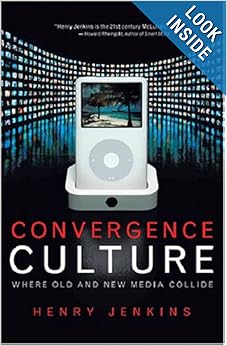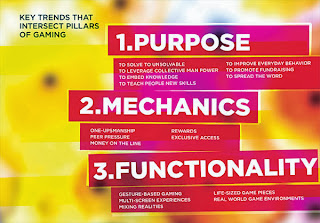This is a question that I've had asked myself back when I was in college at Auburn University. Upon reading the book "Convergence Culture" by Henry Jenkins, I began to ask myself whether or not it is possible to use modern devices in the class room. Many Professors at Auburn told us that Wikipedia was not a reliable source of information, but I had a few who told me that it was just fine, it was a source of knowledge just like a book. It failed to meet many professor's approval because it was in fact digital, not hard back. The American school system is bad, and it needs a change for it to succeed. The way that children and students interact with the world has changed drastically, and yet schools remain exactly how they were back in the late 1800s. So what changes are being made?
Well, to provide an explanation of what school were like, one needs to watch the video "Mr. Dancealot" to get an understanding of what the current theme of a classroom is. In this video, we have a Professor who is teaching dance class. Sounds fun right? Well, he has no interaction between himself and his students, or even students to students. At one point in the video a student claims that it would be fun if they actually got to do any of what he was teaching. One student even tried to get up and make sure he got the moves to the Fox Trot correctly, at which point "Mr. Dancealot" got unto him saying "I'm trying to teach a class here!". At the end, the students are at the final exam and starring at each other with all the information they have gathered during the semester, but no knowledge of how to apply it. This video shows us what non interaction in the classroom is like, and how it is a negative. So how do we change that?
In her video "Harness Your Student's Digital Knowledge", Davis' describes a way of sparking that interaction. At sometimes during her class, students will get up and teach the class themselves, guiding their fellow students in what lesson plan they are in that day. This allows for students to not only interact with each other, but also to help solidify the students own knowledge of the material. She also prescribes to the idea that all the information should not be handed to a student, saying "I don't have to define everything, and I shouldn't." Saying this, she is meaning that when she presents a word to students that they don't know, they have the ability to look it up, expanding their knowledge in multiple ways.
The main cusp of this comes from the video "Teaching in the 21st Century". Here is a video that describes how the classroom is not how we remember it, and that teaching is evolving to the point that technology must be used in it. In the video, Robert's believes that Teaching in the 21st Century means to be a facilitator, a guide, a filter and engager for the students towards the information. To him, the information is already there at the student's finger tips, via sites like Wikipedia and You Tube, and that they need someone to help contextualize the information rather then present it. A teacher must also make their class room engaging, but not by making it entertaining. Entertainment is not engaging, and therefore students will not learn. A teacher will want to ensure that their students are not bored or frustrated with the course, but rather have work that engages their mind and allows them to explore the information. This is important to understand, as those that are wanting to become teachers are the ones that will be bringing this change full front. We, as students, have to empty our minds of what we think teaching is about, and learn how to handle the ever growing area known as "the class room".
So where do we see things like You Tube and Blogs appear in the class room? One of the concepts using this is called "Flipping the Classroom". The "flipping" part comes with the idea that students are given a video to watch at home, and the video is the teacher giving the lecture. This allows students to pause, rewind, and take the lecture at their own pace. The "homework" we are all use to is then did in class, with all the students have had watched the lecture at their own pace, and hopefully having a better understanding. Students are also encouraged to bring questions they have to class, or if they looked something up they can bring that to class as well. Mixing this concept with blog posts, wiki pages and You Tube channels, as seen in "The Networked Student", we can see how teaching has evolved from simple chalkboard and chalk.
Saturday, January 25, 2014
Saturday, January 18, 2014
What about EDM310?
EDM310 seems to be an interesting class. I can say with confidence that this is the first time I have heard of this class, though at Auburn University I did not take any Education Major classes. I have, however, taken a similar class, in which we did detailed work with Twitter and Instagram. Like many classes I have taken, I am fearful that amount of work will overwhelm me. I haven't been in school for the past two years, so I'm a bit rusty. This should not be a problem if I keep myself focused on the goal, but I have to find a nice flow with my classes to ensure the work load doesn't get to ridiculous.
Dr. Strange seems like some of my other professors, he's tough but fair. Since I have not heard the horror stories of this class, or him, I did not have a predetermined idea on this class. Now that I think about it though, I do not think I will have too much trouble with this class. At Auburn, I took a Mythology class in which the professor told us that 30% of the class was up to us. We had to choose our projects and take a more active role in what we learned. In his mind, since we were dealing with what we learned directly, we would retain the knowledge easier and faster.
This class, as it stands now, will help me get over my procrastination, or at the least for this class.....haha.
Dr. Strange seems like some of my other professors, he's tough but fair. Since I have not heard the horror stories of this class, or him, I did not have a predetermined idea on this class. Now that I think about it though, I do not think I will have too much trouble with this class. At Auburn, I took a Mythology class in which the professor told us that 30% of the class was up to us. We had to choose our projects and take a more active role in what we learned. In his mind, since we were dealing with what we learned directly, we would retain the knowledge easier and faster.
This class, as it stands now, will help me get over my procrastination, or at the least for this class.....haha.
Thursday, January 16, 2014
Practice Post
My name is Gregory C. Olson, and it is enjoyable to be back in school. I was born in Pensacola, but grew up around the Mobile area. Though I actually live close to Lucedale, MS, most of my time and energy is spent here. My High School is actually pretty close, as I went to Faith Academy off of Tanner Williams Road. I have already gotten a degree in English from Auburn University. That took a little longer then I expected, seven years in fact! Part of it was due to my own laziness, but that was amplified due to a tragedy that occurred in my family. During my Freshman year my mother passed away, and that sent me into a spiral of depression.
I was able to pull myself out of the rut and found a passion in not only the literature aspect of English, but also gaming. It was during my time in the English department that I discovered that teacher, in both college and grade school, have been looking at ways to use gaming (mostly video games) as a way of teaching. This is one of the things that got me interested in Education. I love introducing people to new stories, and the realm of video gaming is getting to the point that the stories portrayed in them are on the same level as those in books. Back when I did my initial research into this it was still a small field, though it has recently gained momentum in not only the school, but also in the work place.
I was able to pull myself out of the rut and found a passion in not only the literature aspect of English, but also gaming. It was during my time in the English department that I discovered that teacher, in both college and grade school, have been looking at ways to use gaming (mostly video games) as a way of teaching. This is one of the things that got me interested in Education. I love introducing people to new stories, and the realm of video gaming is getting to the point that the stories portrayed in them are on the same level as those in books. Back when I did my initial research into this it was still a small field, though it has recently gained momentum in not only the school, but also in the work place.
Subscribe to:
Posts (Atom)



